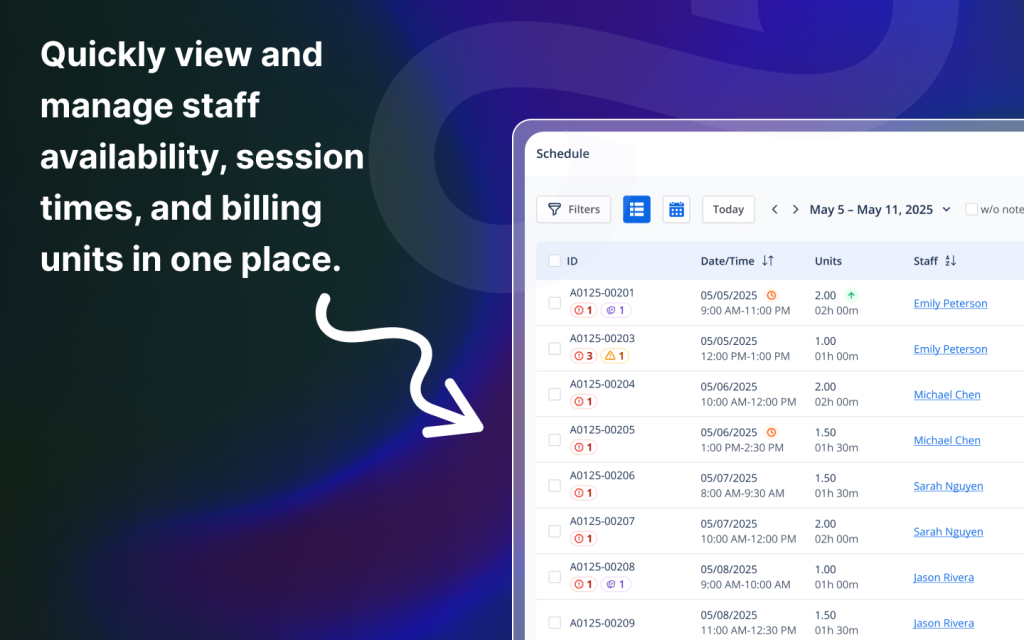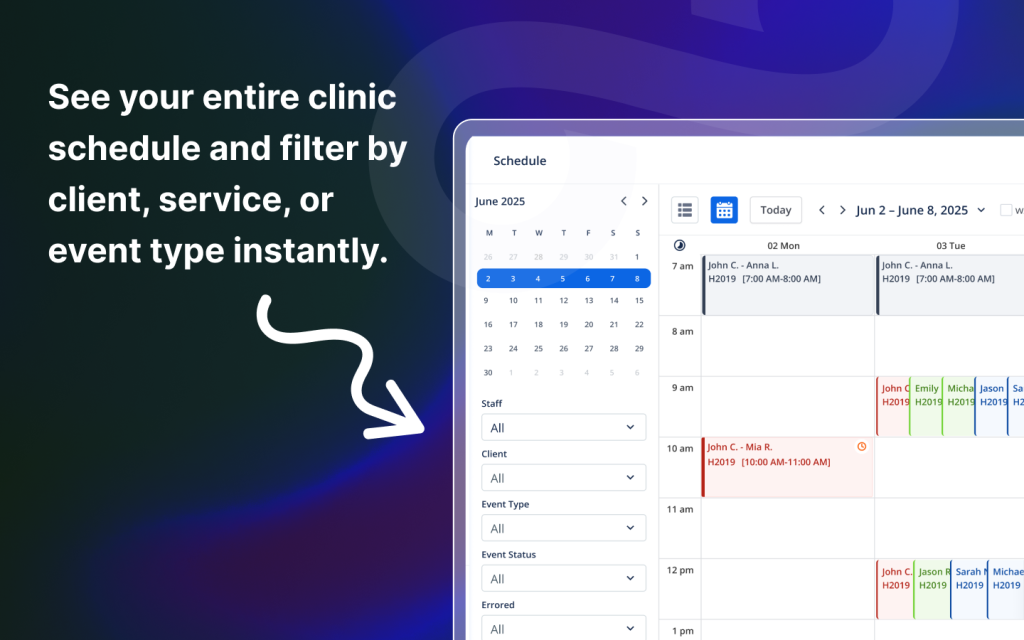Running an ABA clinic without ABA compliance management software is like navigating without a map – small mistakes can quickly snowball into compliance risks, billing delays, and lost revenue. That’s why ABA compliance management software is essential for keeping operations efficient and compliant.
Billing and Revenue Cycle Management in ABA Compliance Management Software
In many cases. ABA software platforms focus on surface-level features – claim forms, session logs, CPT code mapping – but skip the hard work of building the micro-processes that actually keep the clinic compliant and financially secure.
These are things you don’t know you need – until your first payroll cycle fails or payers deny a bulk of claims.
What gets overlooked:
- No guardrails to prevent unqualified staff from scheduling services they can’t bill for
- No credential expiration warnings, resulting in sessions being delivered by non-compliant staff
- No visibility into authorization windows, leading to out-of-bounds services that can’t be reimbursed
- No claim aging views, making it hard to follow up on payments or catch unpaid invoices
Some platforms even advertise “freedom” and “full customization,” but what they’re really offering is a lack of structure – and that structure is what protects your clinic.

An effective ABA practice management system should:
- Automatically flag or block sessions outside valid authorization dates
- Connect directly with clearinghouses for fast, trackable claim submission
- Provide aging dashboards for all claims
- Allow invoice generation for copays, coinsurance, and client balances
- Prevent billing for services delivered by unqualified staff
In short, your system should think like an operations director and compliance officer – because as your clinic grows, there won’t be time to micromanage every detail.
Solutions that do this well, don’t just give you tools – they give you systems that protect your clinic without adding extra work.
Improving Staff and Credential Management
Similarly, a major source of compliance risk in ABA clinics stems from staff credentialing errors – something that most software platforms often underestimate. ABA compliance management software actively prevents these issues by enforcing credential rules and blocking non-compliant staff from being scheduled. Manual tracking via spreadsheets or basic reminders can’t keep up with the level of oversight clinics need to scale safely.
A robust ABA practice management system should do more than store license files. It must actively manage and enforce credential rules by:
- Sending automated alerts before credentials expire (licenses, certifications, TB tests, DOJ clearances)
- Preventing appointments from being scheduled if credentials are missing or invalid
- Supporting covered credential logic, so clinics don’t need to redundantly list sub-credentials (e.g., BCBA covering high school diploma)
- Offering custom role-based access control, to tightly manage permissions at every level – clinical, administrative, and supervisory
Flexibility is important, but in credentialing, structure is safety. The more granular the control, the less room there is for human error. Without these systems in place, clinics risk claim rejections, audit flags, or even liability for services rendered outside the scope of staff qualifications.
Enhancing Client Experience with Compliance-Focused ABA Software
While much of the focus in ABA compliance management software is internal operations, clients and families feel the downstream effects of poor systems immediately.
When clinics assign staff inconsistently, delay documentation or interrupt services due to missing authorizations, clients lose trust, and long-term retention suffers.
A high-quality ABA practice management system enhances client experience by:
- Ensuring appointments stay within authorization dates and unit limits
- Automatically pairing qualified staff with clients – improving consistency
- Storing session documentation in one place for quick retrieval
- Supporting secure digital document uploads and e-signatures from parents or caregivers
- Offering transparency across billing, appointments, and service delivery
These systems reduce friction not just for admin teams, but for families – who often rely on predictability, communication, and clear documentation for funding or school support.

Why Not All ABA Compliance Management Softwares Are Equal
A major mistake many clinic owners make is assuming that all ABA software platforms offer the same level of operational protection. While many products advertise features like scheduling, billing, or credential tracking, the depth and reliability of these features vary dramatically.
The difference lies in the details:
- Do the guardrails actually prevent non-qualified staff from being scheduled?
- Can the scheduler see overlapping availability in a visual, intuitive way?
- Are reauthorization timelines clearly displayed, or hidden deep in menus?
- Does the software stop expired staff credentials from slipping through?
What looks like “more customization” in some platforms often translates to more work, more manual oversight, and a higher risk of non-compliance. In addition, flexibility without embedded logic leaves room for mistakes , and mistakes in ABA can mean denied claims, delayed payments, and regulatory violations.
Case Study: From Manual Chaos to Operational Clarity
Consider a small but growing ABA clinic with 5 BCBAs and 15 RBTs. Initially, they tracked schedules in Google Sheets, logged credentials in Dropbox, and submitted claims manually through payer portals.
Within a year, they faced:
- Payers denied multiple claims due to staff credential mismatches
- Missed reauthorization deadlines leading to unpaid sessions
- Disconnected systems causing administrative burnout
- Scheduling errors reduced staff utilization and client consistency
For this reason, after switching to a purpose-built ABA practice management system, they were able to:
- Automate credential and document compliance
- Visually align staff availability with client authorizations
- Submit claims directly through a clearinghouse with real-time tracking
- Centralize session notes, invoices, and staff/client records into one platform
Therefore, the clinic reduced admin workload by 30%, sped up reimbursements, and tightened compliance across the board. Operational clarity replaced manual chaos , and their team finally had the infrastructure to scale.

Questions to Ask Before Choosing an ABA Practice Management Tool
Before committing to any system, ask these non-negotiable questions:
- Does the platform actively block scheduling errors, or does it just warn you?
- Can it track authorization units down to reserved, completed, and remaining totals?
- Is there a visual scheduling view that shows staff/client availability overlaps?
- How are credential expirations and compliance documents managed?
- Are claims submitted directly through a clearinghouse, or do you still use manual portals?
- Can permissions be granularly assigned to custom roles?
Too many systems answer “yes” to these questions in theory – but fall short in execution. Demo environments are polished; real-world use reveals the gaps.
Conclusion
At first, running an ABA clinic is more than delivering therapy – it’s managing a tightly regulated, operationally complex business. Generic healthcare tools or underbuilt ABA platforms can leave the practice vulnerable to compliance errors, billing issues, and preventable inefficiencies.
The right ABA practice management system doesn’t just digitize the workflow – it safeguards it. As a result, from credential enforcement and scheduling accuracy to payer-ready documentation and real-time authorization tracking, the software should actively protect the clinic from the ground up.
If you’re ready to stop patching systems together and start building a reliable operational foundation, it’s worth exploring tools that were truly built for ABA.
TherapyLake is one such platform. It was developed specifically for ABA clinics, with built-in guardrails, compliance automation, and real-world operational logic. A free trial is available, and custom pricing plans are offered for larger or multi-site practices.
FAQs
1. What’s the difference between ABA practice management software and general EHRs?
ABA practice management software is designed specifically for the workflows and compliance requirements of ABA clinics. Unlike general EHRs, it includes credential enforcement, CPT-specific billing, authorization tracking, and role-based access controls tailored for RBTs, BCBAs, and BTs.
2. Can this kind of software prevent staff from being scheduled if credentials are invalid?
Yes — platforms with built-in guardrails automatically block staff from being assigned to appointments they’re not qualified for, helping avoid claim denials and compliance risks.
3. How does practice management software support billing and reimbursements?
It allows automatic claim submissions through clearinghouse integrations, tracks aging claims, and generates invoices for client responsibility (copay, coinsurance, etc.). This significantly shortens the revenue cycle.
4. Will I still need separate tools for credential tracking and staff management?
No. A robust practice management system should centralize credential management with renewal alerts, covered credential logic, and permissions tied to each role – eliminating the need for external tracking tools.
5. Is ABA practice management software scalable for growing clinics?
Absolutely. Quality platforms are built to scale with your team – offering multi-role management, custom permissions, and the ability to support complex scheduling across multiple locations or service lines.
